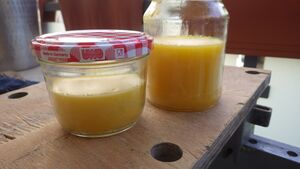Material:Paste Wax
| MaterialInfoBox Paste Wax | |
|---|---|

| |
| Synonyms: | DE: Wachspaste |
| Suggested Tools: | fingers, shop rags |
| Used with: | wood, boiled linseed oil |
| Contains: | (at least) an oil and a wax |
Paste wax is an oil and wax mixture that combines the advantages of both substances for finishing wood surfaces. It is a nice natural finish that can preserve the grainy look and feel of wood, but is not as durable as some synthetic finishes.
It is easily made at home if you don't want to buy it ready to use!
How to Use
James Wright has a pretty nice video about his "boiled linseed oil & paste wax" finishing process - best watch that ;-)
Basically, after you are happy with the oil part of the finish you wipe the workpiece dry and rub a bunch of paste wax into the surface. Wipe off the excess after a couple of minutes, let it harden some more and buff it with a clean shop rag (he uses a sock).
Recipes
There are many ways to mix pastewax, but most recipes center on beeswax and linseed oil.
- James Wright ("Wood by Wright" on YouTube): 3 mixtures, each by volume [1]
- soft: 25% beeswax, 75% linseed oil - easily applied to most projects (he uses boiled linseed oil as a first layer)
- medium: 40% beeswax, 60% linseed oil - more durable finishes (workpieces that will be touched often)
- hard: 67% beeswax, 33% linseed oil - to protect or lubricate tools
- Dominik Ricker (Holz.Hand.Werte): approx. 80% linseed oil, 15% beeswax, 5% carnauba wax [2]
- Lukas: 2 mixtures, by weight
- soft: 60% linseed oil, 40% beeswax
- medium: 80% linseed oil, 20% beeswax
- experience pending - feel free to ask if you'd like to try some!